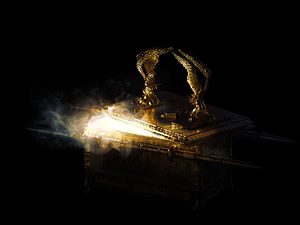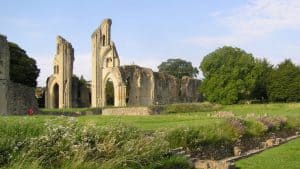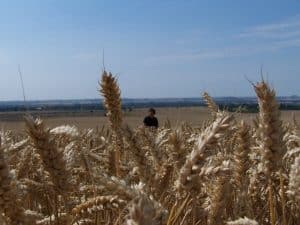A number of authors in the second century BC considered the 7 Wonders of the Ancient World to be the most remarkable and inspiring landmarks in human history. These authors included Philon of Byzantium and Antipater of Sidon.
The Seven Wonders of the Ancient World are:
- the pyramid of Khufu (Cheops),
- the statue of Zeus at Olympia,
- the temple of Artemis in Ephesus,
- the mausoleum at Halicarnassus,
- the colossus of Rhodes,
- the Pharos (lighthouse) of Alexandria
- the hanging gardens of Babylon
They were all situated in the empire of Alexander the Great.

Why were the 7 Wonders of the Ancient World chosen?
The Ancient Wonders of the World could be seen as the bucket list of ancient adventure travelers.
Every structure was an amazing architectural achievement and was probably much talked about by educated and important Greeks.
For instance Antipater of Sidon, a famous poet of the 2nd century BC, wrote:
I have set eyes on the wall of lofty Babylon on which is a road for chariots, and the statue of Zeus by the Alpheus, and the hanging gardens, and the Colossus of the Sun, and the huge labour of the high pyramids, and the vast tomb of Mausolus; but when I saw the house of Artemis that mounted to the clouds, those other marvels lost their brilliancy, and I said, 'Lo, apart from Olympus, the Sun never looked on aught so grand.'
Antipater of Sidon
Another famous writer who mentioned the 7 wonders of the World was Philon of Byzantium. Incidentally, it is now generally believed that his book, “Septem Mundi Miraculis,” might not be his at all. Someone might have used his name to get quick attention for this book.
Anyhow, the list of Wonders of the World is believed to be “established” around 225 BC. Fact is, the list was repeated by later writers and served as an inspiration for wanderlust adventurers for centuries.
The Wonders of the World and Alexander the Great
The Wonders all lay in the legendary empire of Alexander the Great. Even in his own time, Alexander the Great was considered a semi-deity.
Some believed he was the son of Zeus, others thought he was the son of an Egyptian Pharaoh. His life story is impressive. He conquered an enormous area bordering India to the east. He sought to unite the nations under his power while honoring their many religious and cultural traditions. When he died at the young age of 32, his dream was shattered by a struggle for succession.
After his death, the Macedonian Wars raged in locations where some of the world’s greatest wonders are located. It is probable that commanders brought back stories of the magnificent constructions they had seen, inspiring people to visit them and to write about them.
The timeline below shows you where the wonders were located, when they were built and in what period they disappeared.
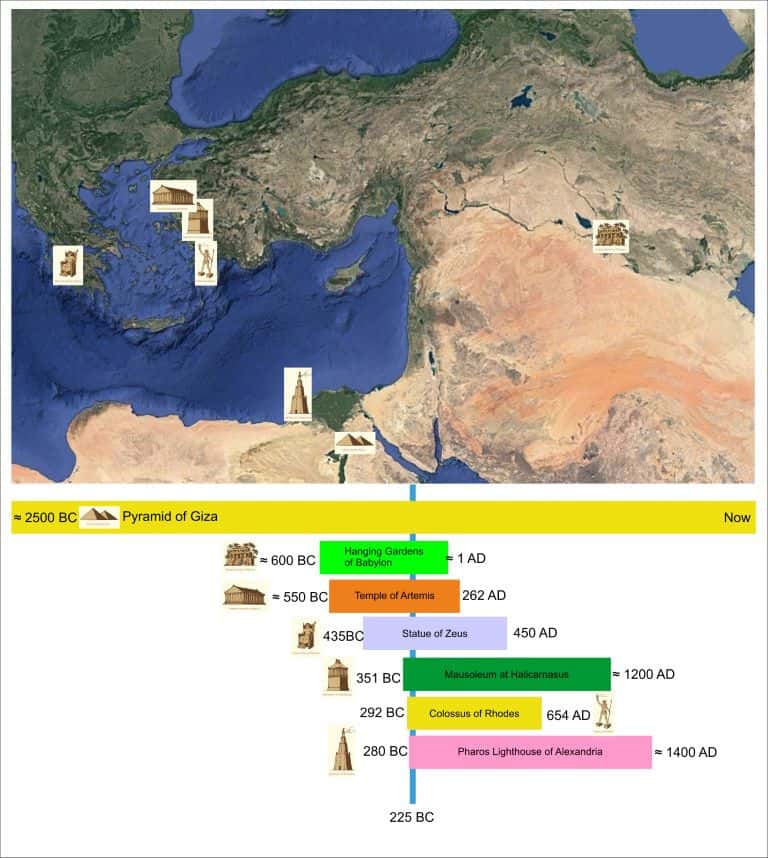
What made the Wonders of the Ancient World Special?
Around 225 BC a number of miracles were downright modern. In our days you could compare them with buildings from the 1970s like the Sidney Opera House (1973) or the Twin Towers of the World Trade Center (1968 and 1971). The lighthouse in Alexandria and the colossus in Rhodes were examples of “modern architecture” and were widely admired at the time.
A number of structures were several centuries old. To us, this is comparable to buildings like the Taj Mahal (1648) or Chartres Cathedral (13th century). They are beautiful buildings, widely admired by the people who have visited them.
And, of course, there were the pyramids, which were already 2,500 years old at the time. Nobody knew how they were made, and they could only stare at them in awe, just like today.
What happened to the 7 Wonders of the Ancient World?
| Name | Picture | What happened? |
| Pyramid of Khufu, Egypte |  | Largest structure of the ancient world. Attributed to Khufu (Cheops) Built under the direction of Hemiunu. Still in existence, but seriously damaged by theft of (cover) stones and treasure hunters. |
Hanging gardens of Babylon, Syria |  | Terraced Gardens, somewhere in Iraq. Exact location unknown, but the British scholar Stephanie Dalley suspects it was not in Babylon but in Nineveh. Little is known about the builders and why the gardens were built. |
| Statue of Zeus at Olympia, Greece |  | Built in 435 BC by the sculptor Phidias at Olympia, where the Olympic Games were held. The statue was destroyed in the 5th century by the rise of Christianity or/and by earthquakes. |
| Temple of Artemis in Ephesus, Turkey |  | Also called the Temple of Diana. Built of marble on the ruins of older temples. The last built was commissioned by Alexander the Great. Burned and looted by the Goths in 268 AD. |
| Mausoleum of Halicarnassus, Turkey |  | Intended and used as a tomb for Mausolus, ruler of Caria, and his sister/wife. Built around 350 BC and destroyed by a series of earthquakes around the 13th century. |
| Colossus of Rhodes, Greece |  | Known only from ancient texts, no archaeological material. Built to celebrate victory over Macedonia. It was more than 100 feet (33 meters) high and was destroyed by an earthquake 66 years after its construction. The ruins of the Colossus were a tourist attraction until Rhodes was conquered by the Arabs in about 654 AD and the bronze was taken as spoils of war. New York’s Statue of Liberty was inspired by the Colossus. |
| Pharos, lighthouse of Alexandria (Pharos), Egypt |  | The tower was constructed between 297 and 283 BC. and served as a lighthouse for the Greeks, Romans, Byzantines and Arabs for almost 1500 years. Destroyed by an earthquake in 1375. |
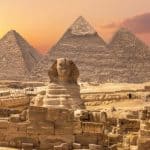
Largest structure of the ancient world. Attributed to Khufu (Cheops) Built under the direction of Hemiunu. Still in existence, but seriously damaged by theft of (cover) stones and treasure hunters.

Terraced Gardens, somewhere in Iraq. Exact location unknown, but the British scholar Stephanie Dalley suspects it was not in Babylon but in Nineveh. Little is known about the builders and why the gardens were built.

Built in 435 BC by the sculptor Phidias at Olympia, where the Olympic Games were held. The statue was destroyed in the 5th century by the rise of Christianity or/and by earthquakes.
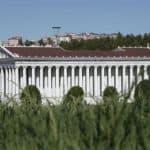
Also called the Temple of Diana. Built of marble on the ruins of older temples. The last built was commissioned by Alexander the Great. Burned and looted by the Goths in 268 AD.

Intended and used as a tomb for Mausolus, ruler of Caria, and his sister/wife. Built around 350 BC and destroyed by a series of earthquakes around the 13th century.

Known only from ancient texts, no archaeological material. Built to celebrate victory over Macedonia. It was more than 100 feet (33 meters) high and was destroyed by an earthquake 66 years after its construction.
The ruins of the Colossus were a tourist attraction until Rhodes was conquered by the Arabs in about 654 AD and the bronze was taken as spoils of war. New York’s Statue of Liberty was inspired by the Colossus.

The tower was constructed between 297 and 283 BC. and served as a lighthouse for the Greeks, Romans, Byzantines and Arabs for almost 1500 years. Destroyed by an earthquake in 1375.
World wonders - an inspiration for centuries
People are still inspired by the world’s ancient wonders. Countless paintings and drawings have been created by painters who were inspired by Antipater’s list of wonders. Later writers would add the Temple of Solomon, the Colosseum in Rome, and Noah’s Ark to the list. These types of additions are referred described as “the eighth wonder of the world.”
In 2001 the New 7 Wonders Foundation was established. This is a non-profit organization that organized campaigns to select “New World Wonders”. This resulted in 3 lists:
- New 7 Wonders of the World
- New 7 wonders of Nature
- New 7 wonders Cities



